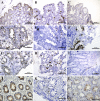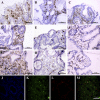Expression of Toll-like receptor 2 (TLR2), TLR4, and CD14 in biopsy samples of patients with inflammatory bowel diseases: upregulated expression of TLR2 in terminal ileum of patients with ulcerative colitis
- PMID: 18040078
- PMCID: PMC2324181
- DOI: 10.1369/jhc.7A7303.2007
Expression of Toll-like receptor 2 (TLR2), TLR4, and CD14 in biopsy samples of patients with inflammatory bowel diseases: upregulated expression of TLR2 in terminal ileum of patients with ulcerative colitis
Abstract
Dysregulation of innate and adaptive intestinal immune responses to bacterial microbiota is supposed to be involved in pathogenetic mechanisms of inflammatory bowel diseases (IBDs). We investigated expression of Toll-like receptor 2 (TLR2), TLR4, and their transmembrane coreceptor CD14 in biopsy samples from patients with IBD and in non-inflamed gut mucosa from controls. Small intestine and colon samples were obtained by colonoscopy from patients with Crohn's disease (CD), ulcerative colitis (UC), and controls. Immunohistochemical analysis of cryostat sections using polyclonal and monoclonal antibodies specific for TLR2, TLR4, and CD14 showed a significant increase in TLR2 expression in the terminal ileum of patients with inactive and active UC against controls. Significant upregulation of TLR4 expression relative to controls was found in the terminal ileum and rectum of UC patients in remission and in the terminal ileum of CD patients with active disease. CD14 expression was upregulated in the terminal ileum of CD patients in remission and with active disease, in the cecum of UC patients in remission and with active disease, and in rectum of UC patients with active disease. Hence, dysregulation of TLR2, TLR4, and CD14 expression in different parts of the intestinal mucosa may be crucial in IBD pathogenesis.
Figures


Comment in
-
Expression of Toll-like receptors in the intestinal mucosa of patients with inflammatory bowel disease.Expert Rev Gastroenterol Hepatol. 2008 Apr;2(2):193-6. doi: 10.1586/17474124.2.2.193. Expert Rev Gastroenterol Hepatol. 2008. PMID: 19072354
Similar articles
-
Expression and implication of toll-like receptors TLR2, TLR4 and TLR9 in colonic mucosa of patients with ulcerative colitis.J Huazhong Univ Sci Technolog Med Sci. 2014 Oct;34(5):785-790. doi: 10.1007/s11596-014-1353-6. Epub 2014 Oct 16. J Huazhong Univ Sci Technolog Med Sci. 2014. PMID: 25318894
-
Expression of Toll-like receptors in the intestinal mucosa of patients with inflammatory bowel disease.Expert Rev Gastroenterol Hepatol. 2008 Apr;2(2):193-6. doi: 10.1586/17474124.2.2.193. Expert Rev Gastroenterol Hepatol. 2008. PMID: 19072354
-
Increased production of soluble TLR2 by lamina propria mononuclear cells from ulcerative colitis patients.Immunobiology. 2012 Jun;217(6):634-42. doi: 10.1016/j.imbio.2011.10.023. Epub 2011 Nov 3. Immunobiology. 2012. PMID: 22101184
-
Development, validation and implementation of an in vitro model for the study of metabolic and immune function in normal and inflamed human colonic epithelium.Dan Med J. 2015 Jan;62(1):B4973. Dan Med J. 2015. PMID: 25557335 Review.
-
Morphology of inflammatory bowel diseases (IBD).Cesk Patol. 2022 Spring;58(1):27-37. Cesk Patol. 2022. PMID: 35387455 Review. English.
Cited by
-
Expression of Toll-like receptors in the mucosa of patients with ulcerative colitis.Exp Ther Med. 2015 Apr;9(4):1455-1459. doi: 10.3892/etm.2015.2258. Epub 2015 Feb 4. Exp Ther Med. 2015. PMID: 25780451 Free PMC article.
-
Toll-like receptors 2 and 4 modulate intestinal IL-10 differently in ileum and colon.United European Gastroenterol J. 2018 Apr;6(3):446-453. doi: 10.1177/2050640617727180. Epub 2017 Aug 23. United European Gastroenterol J. 2018. PMID: 29774159 Free PMC article.
-
Transcript levels of Toll-Like Receptors 5, 8 and 9 correlate with inflammatory activity in Ulcerative Colitis.BMC Gastroenterol. 2011 Dec 20;11:138. doi: 10.1186/1471-230X-11-138. BMC Gastroenterol. 2011. PMID: 22185629 Free PMC article.
-
Anti-Inflammatory Effect of Dietary Pentadecanoic Fatty Acid Supplementation on Inflammatory Bowel Disease in SAMP1/YitFc Mice.Nutrients. 2024 Sep 8;16(17):3031. doi: 10.3390/nu16173031. Nutrients. 2024. PMID: 39275347 Free PMC article.
-
Gut microbiota and transcriptome profiling revealed the protective effect of aqueous extract of Tetrastigma hemsleyanum leaves on ulcerative colitis in mice.Curr Res Food Sci. 2022 Dec 28;6:100426. doi: 10.1016/j.crfs.2022.100426. eCollection 2023. Curr Res Food Sci. 2022. PMID: 36618099 Free PMC article.
References
-
- Abreu MT, Arnold ET, Thomas LS, Gonsky R, Zhou Y, Hu B, Arditi M (2002) TLR4 and MD-2 expression is regulated by immune-mediated signals in human intestinal epithelial cells. J Biol Chem 227:20431–20437 - PubMed
-
- Aderem A, Ulevitch RJ (2000) Toll-like receptors in the induction of the innate immune response. Nature 406:782–787 - PubMed
-
- Akira S, Hemmi H (2003) Recognition of pathogen-associated molecular patterns by TLR family. Immunol Lett 85:85–95 - PubMed
-
- Autschbach F, Giese T, Gassler N, Sido B, Heuschen G, Heuschen U, Zuna I, et al. (2002) Cytokine/chemokine messenger-RNA expression profiles in ulcerative colitis and Crohn's disease. Virchows Arch 441:500–513 - PubMed
-
- Best WR (2006) Predicting the Crohn's disease activity index from the Harvey-Bradshaw Index. Inflamm Bowel Dis 12:304–310 - PubMed
Publication types
MeSH terms
Substances
LinkOut - more resources
Full Text Sources
Other Literature Sources
Medical
Research Materials

